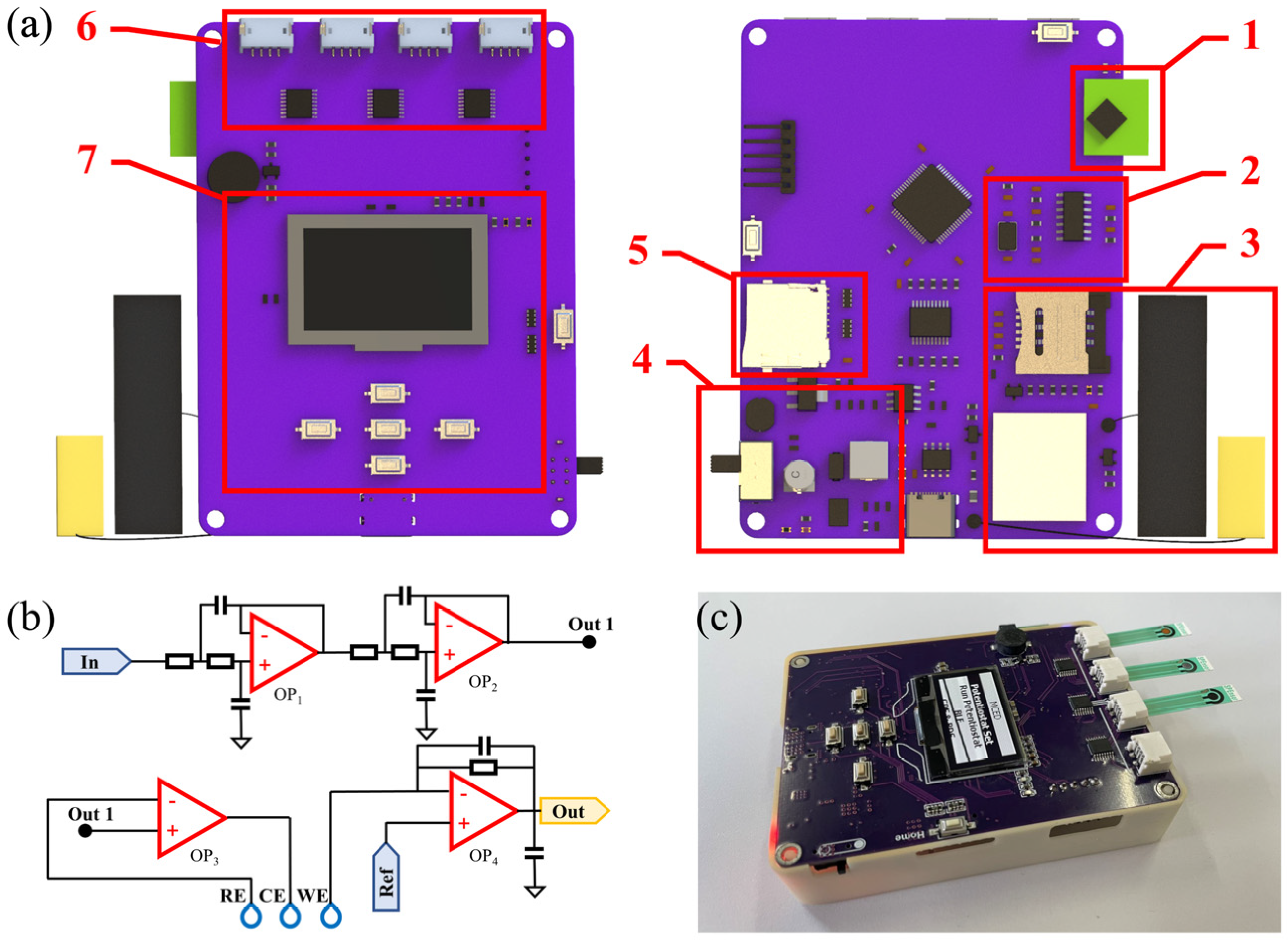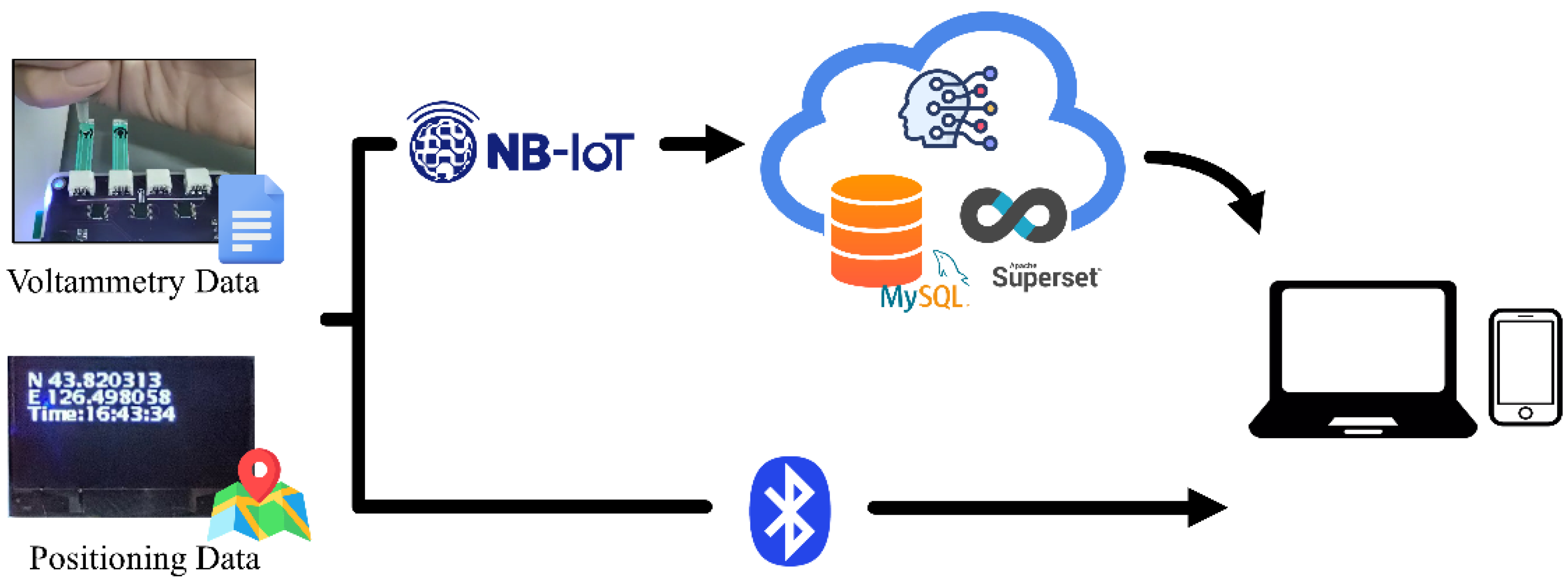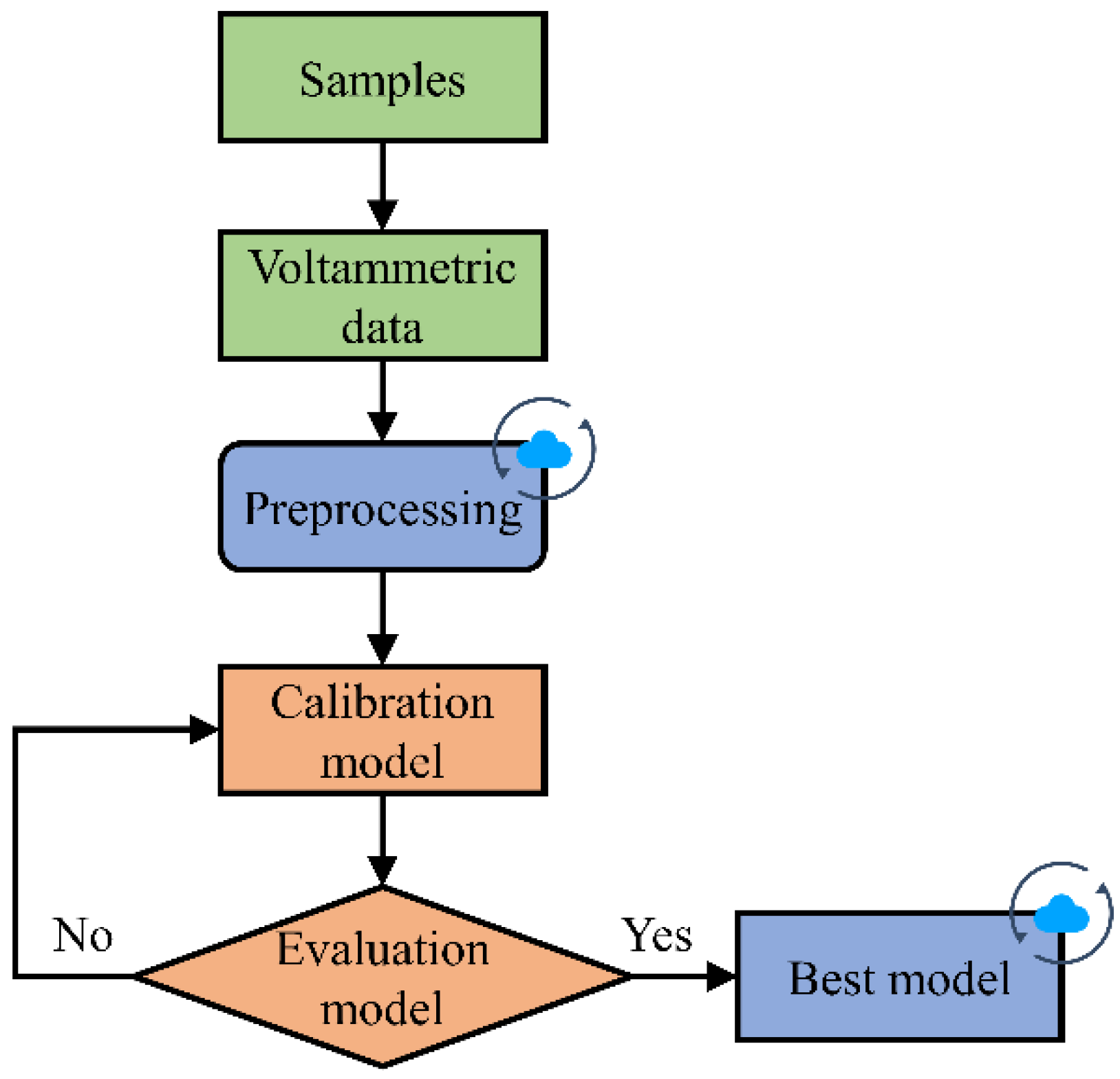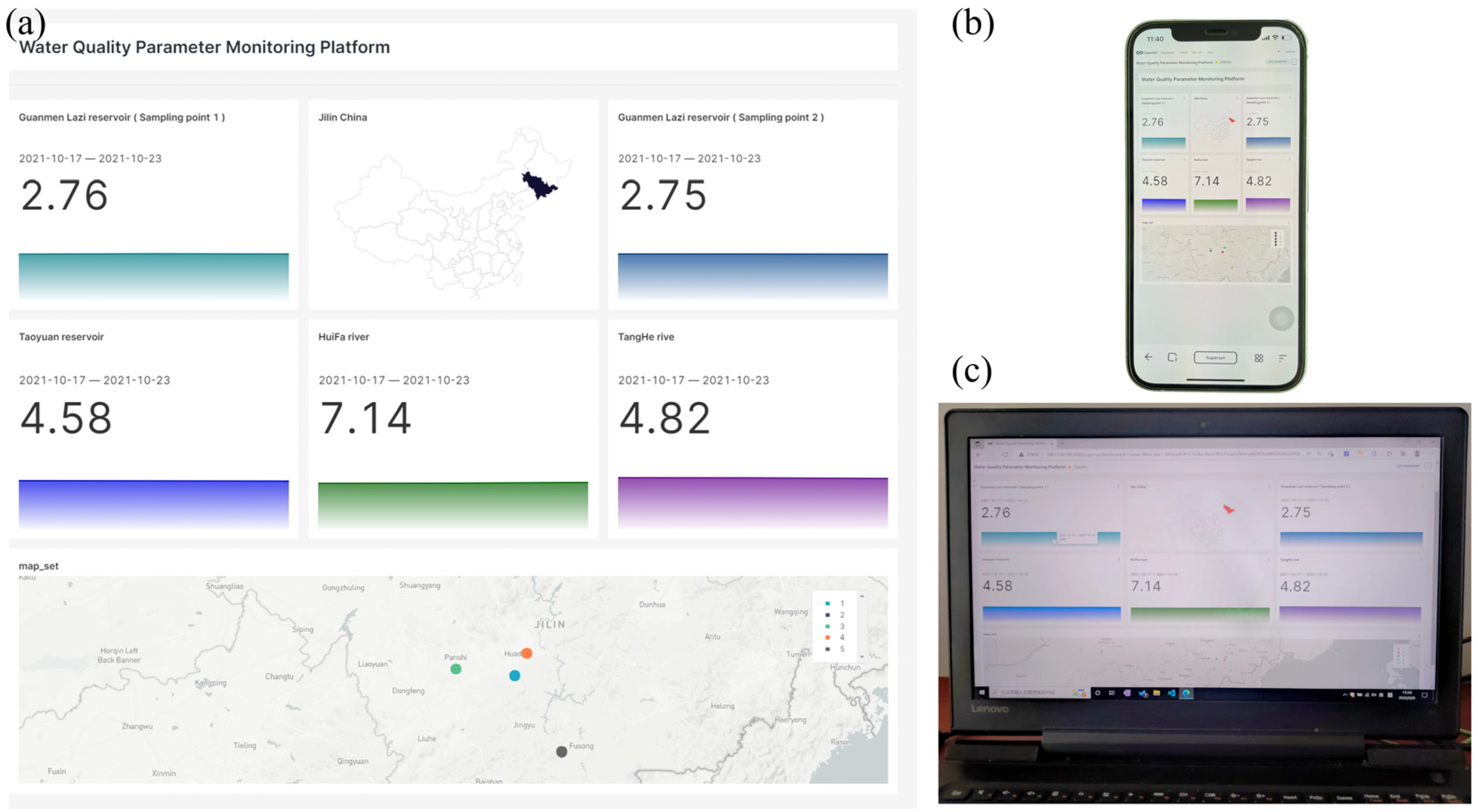Portable Multi-Channel Electrochemical Device with Good Interaction and Wireless Connection for On-Site Testing
Abstract
:1. Introduction
2. Design of the PMCED
2.1. Potentiostat
2.2. Multiplexer
2.3. User Interface
3. Wireless Communication System
4. Data Analysis and Processing
5. Results and Discussion
5.1. Electrochemical Performance of the PMCED
5.2. Sample Processing and Chemometric Analysis
5.3. Cloud Computing and Visualization
6. Conclusions
Author Contributions
Funding
Data Availability Statement
Conflicts of Interest
References
- Glasgow, H.B.; Burkholder, J.M.; Reed, R.E.; Lewitus, A.J.; Kleinman, J.E. Real-Time Remote Monitoring of Water Quality: A Review of Current Applications, and Advancements in Sensor, Telemetry, and Computing Technologies. J. Exp. Mar. Biol. Ecol. 2004, 300, 409–448. [Google Scholar] [CrossRef]
- Kirschke, S.; Avellán, T.; Bärlund, I.; Bogardi, J.J.; Carvalho, L.; Chapman, D.; Dickens, C.W.S.; Irvine, K.; Lee, S.; Mehner, T.; et al. Capacity Challenges in Water Quality Monitoring: Understanding the Role of Human Development. Environ. Monit. Assess. 2020, 192, 298. [Google Scholar] [CrossRef] [PubMed] [Green Version]
- Jia, Y.; Liu, G.; Xu, G.; Li, X.; Shi, Z.; Cheng, C.; Xu, D.; Lu, Y.; Liu, Q. Battery-Free and Wireless Tag for in Situ Sensing of Urinary Albumin/Creatinine Ratio (ACR) for the Assessment of Albuminuria. Sens. Actuators B Chem. 2022, 367, 132050. [Google Scholar] [CrossRef]
- Ji, D.; Shi, Z.; Liu, Z.; Low, S.S.; Zhu, J.; Zhang, T.; Chen, Z.; Yu, X.; Lu, Y.; Lu, D.; et al. Smartphone-Based Square Wave Voltammetry System with Screen-Printed Graphene Electrodes for Norepinephrine Detection. Smart Mater. Med. 2020, 1, 1–9. [Google Scholar] [CrossRef]
- Dryden, M.D.M.; Wheeler, A.R. DStat: A Versatile, Open-Source Potentiostat for Electroanalysis and Integration. PLoS ONE 2015, 10, e0140349. [Google Scholar] [CrossRef] [PubMed] [Green Version]
- Ainla, A.; Mousavi, M.P.S.; Tsaloglou, M.-N.; Redston, J.; Bell, J.G.; Fernández-Abedul, M.T.; Whitesides, G.M. Open-Source Potentiostat for Wireless Electrochemical Detection with Smartphones. Anal. Chem. 2018, 90, 6240–6246. [Google Scholar] [CrossRef] [PubMed] [Green Version]
- Demirhan, A.; Eksin, E.; Kilic, Y.; Erdem, A. Low-Cost High-Resolution Potentiostat for Electrochemical Detection of Nucleic Acids and Biomolecular Interactions. Micromachines 2022, 13, 1610. [Google Scholar] [CrossRef]
- Yamanaka, K.; Vestergaard, M.C.; Tamiya, E. Printable Electrochemical Biosensors: A Focus on Screen-Printed Electrodes and Their Application. Sensors 2016, 16, 1761. [Google Scholar] [CrossRef] [Green Version]
- García-Miranda Ferrari, A.; Rowley-Neale, S.J.; Banks, C.E. Screen-Printed Electrodes: Transitioning the Laboratory in-to-the Field. Talanta Open 2021, 3, 100032. [Google Scholar] [CrossRef]
- Shi, Z.; Li, X.; Shuai, Y.; Lu, Y.; Liu, Q. The Development of Wearable Technologies and Their Potential for Measuring Nutrient Intake: Towards Precision Nutrition. Nutr. Bull. 2022, 47, 388–406. [Google Scholar] [CrossRef]
- Ji, D.; Low, S.S.; Zhang, D.; Liu, L.; Lu, Y.; Liu, Q. Smartphone-Based Electrochemical System for Biosensors and Biodetection. Biomed. Eng. Technol. 2022, 2393, 493–514. [Google Scholar] [CrossRef]
- Li, S.; Liu, J.; Chen, Z.; Lu, Y.; Low, S.S.; Zhu, L.; Cheng, C.; He, Y.; Chen, Q.; Su, B.; et al. Electrogenerated Chemiluminescence on Smartphone with Graphene Quantum Dots Nanocomposites for Escherichia Coli Detection. Sens. Actuators B Chem. 2019, 297, 126811. [Google Scholar] [CrossRef]
- Akhter, F.; Siddiquei, H.R.; Alahi, M.E.E.; Jayasundera, K.P.; Mukhopadhyay, S.C. An IoT-Enabled Portable Water Quality Monitoring System With MWCNT/PDMS Multifunctional Sensor for Agricultural Applications. IEEE Internet Things J. 2022, 9, 14307–14316. [Google Scholar] [CrossRef]
- Rego, G.; Ferrero, F.; Valledor, M.; Campo, J.C.; Forcada, S.; Royo, L.J.; Soldado, A. A Portable IoT NIR Spectroscopic System to Analyze the Quality of Dairy Farm Forage. Comput. Electron. Agric. 2020, 175, 105578. [Google Scholar] [CrossRef]
- Iliescu, F.S.; Hong, L.T.; Toh, J.M.J.; Suchea, M.P.; Ionescu, O.N.; Iliescu, C. Early Notice Pointer, an IoT-like Platform for Point-of-Care Feet and Body Balance Screening. Micromachines 2022, 13, 682. [Google Scholar] [CrossRef] [PubMed]
- Bødker, S. Through the Interface: A Human Activity Approach to User Interface Design, 1st ed.; CRC Press: Boca Raton, FL, USA, 2021; ISBN 978-1-00-306397-1. [Google Scholar]
- Azari, A.; Stefanovic, C.; Popovski, P.; Cavdar, C. On the Latency-Energy Performance of NB-IoT Systems in Providing Wide-Area IoT Connectivity. IEEE Trans. Green Commun. Netw. 2020, 4, 57–68. [Google Scholar] [CrossRef]
- Martinez, B.; Adelantado, F.; Bartoli, A.; Vilajosana, X. Exploring the Performance Boundaries of NB-IoT. IEEE Internet Things J. 2019, 6, 5702–5712. [Google Scholar] [CrossRef] [Green Version]
- Migabo, E.M.; Djouani, K.D.; Kurien, A.M. The Narrowband Internet of Things (NB-IoT) Resources Management Performance State of Art, Challenges, and Opportunities. IEEE Access 2020, 8, 97658–97675. [Google Scholar] [CrossRef]
- Beyene, Y.D.; Jantti, R.; Ruttik, K.; Iraji, S. On the Performance of Narrow-Band Internet of Things (NB-IoT). In Proceedings of the 2017 IEEE Wireless Communications and Networking Conference (WCNC), San Francisco, CA, USA, 19–22 March 2017; pp. 1–6. [Google Scholar]
- Mustafa, S.; Nazir, B.; Hayat, A.; Khan, A.U.R.; Madani, S.A. Resource Management in Cloud Computing: Taxonomy, Prospects, and Challenges. Comput. Electr. Eng. 2015, 47, 186–203. [Google Scholar] [CrossRef]
- Rosenthal, A.; Mork, P.; Li, M.H.; Stanford, J.; Koester, D.; Reynolds, P. Cloud Computing: A New Business Paradigm for Biomedical Information Sharing. J. Biomed. Inform. 2010, 43, 342–353. [Google Scholar] [CrossRef]
- Yang, P.; Xiong, N.; Ren, J. Data Security and Privacy Protection for Cloud Storage: A Survey. IEEE Access 2020, 8, 131723–131740. [Google Scholar] [CrossRef]
- Ding, L.; Wang, Z.; Wang, X.; Wu, D. Security Information Transmission Algorithms for IoT Based on Cloud Computing. Comput. Commun. 2020, 155, 32–39. [Google Scholar] [CrossRef]
- Tan, J.F.; Anastasi, A.; Chandra, S. Electrochemical Detection of Nitrate, Nitrite and Ammonium for on-Site Water Quality Monitoring. Curr. Opin. Electrochem. 2022, 32, 100926. [Google Scholar] [CrossRef]
- Graveline, N.; Maton, L.; Rinaudo, J.-D.; Lückge, H.; Interwies, E.; Rouillard, J.; Strosser, P.; Palkaniete, K.; Taverne, D. An Operational Perspective on Potential Uses and Constraints of Emerging Tools for Monitoring Water Quality. TrAC Trends Anal. Chem. 2010, 29, 378–384. [Google Scholar] [CrossRef] [Green Version]
- Thomas, O.; Pouet, M.-F. Wastewater Quality Monitoring: On-Line/On-Site Measurement. Water Pollut. 2004, 2, 245–272. [Google Scholar] [CrossRef]
- Ye, F.; Kameyama, S. Long-Term Spatiotemporal Changes of 15 Water-Quality Parameters in Japan: An Exploratory Analysis of Countrywide Data during 1982–2016. Chemosphere 2020, 242, 125245. [Google Scholar] [CrossRef]
- Wu, H.; Yang, W.; Yao, R.; Zhao, Y.; Zhao, Y.; Zhang, Y.; Yuan, Q.; Lin, A. Evaluating Surface Water Quality Using Water Quality Index in Beiyun River, China. Environ. Sci. Pollut. Res. 2020, 27, 35449–35458. [Google Scholar] [CrossRef]
- Vasistha, P.; Ganguly, R. Water Quality Assessment of Natural Lakes and Its Importance: An Overview. Mater. Today Proc. 2020, 32, 544–552. [Google Scholar] [CrossRef]
- Ji, D.; Liu, Z.; Liu, L.; Low, S.S.; Lu, Y.; Yu, X.; Zhu, L.; Li, C.; Liu, Q. Smartphone-Based Integrated Voltammetry System for Simultaneous Detection of Ascorbic Acid, Dopamine, and Uric Acid with Graphene and Gold Nanoparticles Modified Screen-Printed Electrodes. Biosens. Bioelectron. 2018, 119, 55–62. [Google Scholar] [CrossRef]
- Xu, K.; Chen, Q.; Zhao, Y.; Ge, C.; Lin, S.; Liao, J. Cost-Effective, Wireless, and Portable Smartphone-Based Electrochemical System for on-Site Monitoring and Spatial Mapping of the Nitrite Contamination in Water. Sens. Actuators B Chem. 2020, 319, 128221. [Google Scholar] [CrossRef]
- Liu, J.; Xu, Y.; Liu, M.; Low, S.S.; Zhan, H.; Liu, S.; Ning, H.; Xu, D.; Fang, H.; Liu, Q. Multiplex Analysis of Fundamental Surface Water Quality Indicators by Multi-Channel Electrochemical Device Combined with MFCSC Model. IEEE Sens. J. 2022, 1. [Google Scholar] [CrossRef]
- González, A.G.; Herrador, M.A.; Asuero, A.G. Intra-Laboratory Testing of Method Accuracy from Recovery Assays. Talanta 1999, 48, 729–736. [Google Scholar] [CrossRef] [PubMed]







| Name | Description | Quantity | Unit Price ($) | Total ($) |
|---|---|---|---|---|
| STM32F103RC | MCU | 1 | 2.8 | 2.8 |
| AD8608 | Quad Op-amp | 1 | 3.0 | 3.0 |
| REF196 | 3.3 V Reference | 1 | 1.4 | 1.4 |
| AMS1117 | 3.3 V Regulator | 1 | 0.14 | 0.14 |
| CH9140 | BLE Module | 1 | 1.4 | 1.4 |
| BC20 | NB-IoT & GNSS Module | 1 | 4.7 | 4.7 |
| TXS0108EPWR | Voltage translator | 1 | 0.72 | 0.72 |
| TP5400 | Li-ion battery management | 1 | 0.07 | 0.07 |
| ADG708BRUZ | 8-channel multiplexers | 3 | 2.15 | 6.45 |
| CH340N | USB to TTL | 1 | 0.28 | 0.28 |
| Passive elements | Resistors and capacitors | 36 | 0.02 | 0.72 |
| USB connector | USB type-C connector | 1 | 0.14 | 0.14 |
| Keys | Button | 8 | 0.0175 | 0.14 |
| OLED | Monochrome display panel | 1 | 2 | 2 |
| Lithium battery | 3000 mAh battery | 1 | 4.3 | 4.3 |
| Total Cost: | 28.26 | |||
| Concentration (mM) | Peak Current (μA) | |||
|---|---|---|---|---|
| CV | DPV | |||
| PMCED | CHI760E | PMCED | CHI760E | |
| 0.0156 | 0.137 | 0.125 | 0.403 | 0.373 |
| 0.0313 | 0.251 | 0.185 | 0.541 | 0.519 |
| 0.0625 | 0.290 | 0.365 | 0.689 | 0.904 |
| 0.125 | 0.698 | 0.573 | 1.480 | 1.240 |
| 0.250 | 1.443 | 1.230 | 2.591 | 2.834 |
| 0.500 | 2.324 | 2.306 | 5.134 | 5.021 |
| 1.00 | 4.040 | 3.973 | 8.782 | 6.411 |
| 2.00 | 6.853 | 7.464 | 15.762 | 11.138 |
| 4.00 | 12.392 | 14.952 | 24.137 | 22.405 |
| 8.00 | 24.120 | 27.013 | 38.935 | 31.649 |
| PMCED Detected (mg/L) | Water Quality Test Station Detected (mg/L) | Recovery (%) | |
|---|---|---|---|
| Sample 1 | 4.71 | 4.89 | 96.3 |
| Sample 2 | 2.98 | 2.75 | 108.4 |
| Sample 3 | 3.49 | 2.75 | 126.9 |
| Sample 4 | 4.30 | 4.62 | 93.1 |
| Sample 5 | 6.51 | 6.99 | 93.1 |
| Sample 6 | 4.99 | 4.89 | 102 |
| RMSE (mg/L): 0.44 | R2: 0.91 | ||
Disclaimer/Publisher’s Note: The statements, opinions and data contained in all publications are solely those of the individual author(s) and contributor(s) and not of MDPI and/or the editor(s). MDPI and/or the editor(s) disclaim responsibility for any injury to people or property resulting from any ideas, methods, instructions or products referred to in the content. |
© 2023 by the authors. Licensee MDPI, Basel, Switzerland. This article is an open access article distributed under the terms and conditions of the Creative Commons Attribution (CC BY) license (https://creativecommons.org/licenses/by/4.0/).
Share and Cite
Xu, Y.; Ning, H.; Yu, S.; Liu, S.; Zhang, Y.; Niu, C.; Zhang, Y.; Low, S.S.; Liu, J. Portable Multi-Channel Electrochemical Device with Good Interaction and Wireless Connection for On-Site Testing. Micromachines 2023, 14, 142. https://doi.org/10.3390/mi14010142
Xu Y, Ning H, Yu S, Liu S, Zhang Y, Niu C, Zhang Y, Low SS, Liu J. Portable Multi-Channel Electrochemical Device with Good Interaction and Wireless Connection for On-Site Testing. Micromachines. 2023; 14(1):142. https://doi.org/10.3390/mi14010142
Chicago/Turabian StyleXu, Yifei, Haohao Ning, Shixin Yu, Shikun Liu, Yan Zhang, Chunyan Niu, Yongzhuo Zhang, Sze Shin Low, and Jingjing Liu. 2023. "Portable Multi-Channel Electrochemical Device with Good Interaction and Wireless Connection for On-Site Testing" Micromachines 14, no. 1: 142. https://doi.org/10.3390/mi14010142






